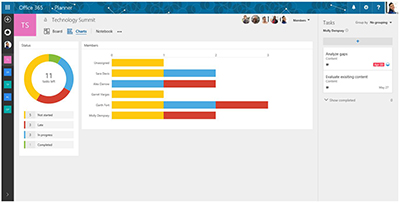News
Microsoft Planner Now Available to Office 365 Subscribers
The Microsoft Planner service has gone live and is being rolled out gradually to Office 365 business and education subscribers worldwide, starting as early as today.
Microsoft Planner was previously available at the preview stage, where it went by the "Office 365 Planner" product name. It's now being delivered to organizations with "Office 365 Enterprise E1–E5, Business Essentials, Premium and Education subscription plans," with availability expected in "the next several weeks," according to Microsoft's announcement.
This application is designed to let organizations set up collaboration plans for getting projects done with other people. The Microsoft Planner interface has so-called "Cards," which are used to show assigned tasks within the overall project's "Board." There's also a "Hub" or "Charts" view that graphically shows a plan's progress, including who's behind schedule in a color-coded scheme (see screenshot).
 [Click on image for larger view.]
Overall view of a plan using Microsoft Planner. Source: Office blog post.
[Click on image for larger view.]
Overall view of a plan using Microsoft Planner. Source: Office blog post.
A user creates a plan, assigns tasks with dates, sorts the tasks and then assigns people to the tasks, according to Microsoft's quick-start guide.
Microsoft Planner uses the Office 365 Groups capability. It will automatically create a Group, which shows information about resources and people in an organization. In addition, every Office 365 Group automatically will have Microsoft Planner capabilities.
Microsoft Planner will just arrive by default for Office 365 subscribers, without intervention by IT pros, which might be something for them to consider. The only end users that won't automatically get this application will be Office 365 Government plan users and organizations subscribing to Office 365 through China's 21Vianet Group, according to a Microsoft support document for IT pros.
If IT pros want to control the arrival of Microsoft Planner, then they will have to use the Office 365 Admin Center or Office 365 PowerShell to remove access to users, which means revoking the Microsoft Planner license. Exercising control over who can create Groups is done through Azure Active Directory PowerShell cmdlets.
The new Microsoft Planner solution works with e-mail hosted on Exchange Server. It will work differently depending on an organization's e-mail architecture. Users get full functionality with Exchange Online use. Hybrid e-mail environments that have on-premises mailboxes "may have issues with viewing or adding comments to a task" and "may have issues viewing their Favorite plans in Planner," Microsoft's support document explained.
Microsoft Planner possibly supplements, or maybe can serve as a replacement for SharePoint Tasks, according to an early view by Microsoft Most Valuable Professional and SharePoint expert Christian Buckley.
About the Author
Kurt Mackie is senior news producer for 1105 Media's Converge360 group.